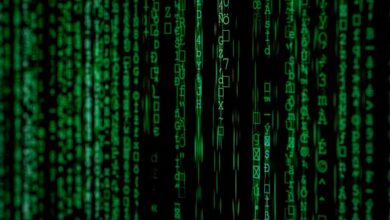Quantum Cryptography: Unbreakable Data Encryption


Are you worried about the security of your data? In today’s digital age, where information is constantly being transmitted and stored, ensuring the confidentiality and integrity of sensitive data has become more crucial than ever. That’s where quantum cryptography comes into play—an advanced technology that promises unbreakable data encryption.
Quantum cryptography leverages the principles of quantum mechanics to provide secure communication channels. Unlike traditional encryption methods, which rely on complex mathematical algorithms, quantum cryptography utilizes the fundamental properties of quantum physics to achieve unprecedented levels of security.

At the heart of quantum cryptography is the phenomenon of quantum entanglement. Entanglement occurs when two particles become interdependent, regardless of the distance between them. This means that any changes made to one particle will instantly affect the other, no matter how far apart they may be. By utilizing entangled particles as carriers of cryptographic keys, quantum cryptography ensures that any attempt to intercept or eavesdrop on the communication will result in the disturbance of the entangled system, making it immediately detectable.
One of the key benefits of quantum cryptography is its ability to detect any unauthorized access. Through a process called quantum key distribution (QKD), cryptographic keys are generated and exchanged between the sender and receiver in a secure manner. Any attempt to tamper with the transmitted keys will introduce errors, providing an immediate alert that the communication has been compromised. This makes quantum cryptography highly resistant to both eavesdropping and tampering attacks.
Furthermore, quantum cryptography offers long-term security by addressing the potential threats posed by advances in computing power. With the advent of quantum computers, traditional encryption methods could be at risk of being broken. However, quantum cryptography provides a future-proof solution by leveraging the principles of quantum physics, which are inherently resistant to quantum computing attacks.
Quantum cryptography represents a major breakthrough in data security. By harnessing the power of quantum mechanics, it offers unbreakable encryption that can protect sensitive information from unauthorized access. With its ability to detect any intrusion and resist quantum computing attacks, quantum cryptography ensures the confidentiality and integrity of data in an increasingly interconnected world. So, if you value the security of your information, quantum cryptography is the way to go.
Unlocking the Future: Quantum Cryptography Paves the Way for Unbreakable Data Encryption
Imagine a world where your most sensitive information is completely secure, untouchable by any hacker or cybercriminal. It may sound like something out of a sci-fi movie, but thanks to the mind-boggling advancements in quantum cryptography, this future may not be too far away. In this article, we’ll delve into the fascinating realm of quantum cryptography and explore how it is revolutionizing data encryption, making it virtually unbreakable.
So, what exactly is quantum cryptography? At its core, it leverages the principles of quantum mechanics to create secure communication channels. Traditional encryption methods rely on complex mathematical algorithms, which can potentially be cracked given enough time and computational power. Quantum cryptography, on the other hand, takes advantage of the fundamental properties of quantum physics, such as superposition and entanglement, to provide an unprecedented level of security.
One of the key concepts in quantum cryptography is quantum key distribution (QKD). QKD enables the exchange of cryptographic keys between two parties in a way that is inherently secure. Unlike traditional methods that require transmitting the key over a vulnerable channel, QKD utilizes the principles of quantum mechanics to establish a key without the risk of interception. Any attempt to eavesdrop on the communication would disrupt the delicate quantum state, alerting both parties to the presence of an intruder.
The implications of quantum cryptography are immense. With the ever-increasing volume of sensitive data being transmitted across networks, ensuring its confidentiality is paramount. Industries such as finance, healthcare, and government institutions stand to benefit greatly from this breakthrough technology. Financial transactions, medical records, and classified information could all be shielded by unbreakable encryption, giving individuals and organizations peace of mind.
While the potential of quantum cryptography is awe-inspiring, there are still challenges to overcome before it becomes widely adopted. The implementation of quantum cryptography requires sophisticated hardware and infrastructure, and the technology is still in its infancy. However, researchers and scientists around the world are working tirelessly to overcome these hurdles and unlock the full potential of this groundbreaking technology.
Quantum cryptography holds the key to a future where data encryption is truly unbreakable. By harnessing the power of quantum mechanics, this emerging field is paving the way for a new era of secure communication. With continued advancements and investments, we may soon witness a revolution in cybersecurity, making our digital world a safer place for everyone.
Quantum Cryptography: Bolstering Security in the Digital Age
Are you worried about the security of your digital information? In today’s fast-paced and interconnected world, it’s crucial to protect our sensitive data from prying eyes. That’s where quantum cryptography comes into play, revolutionizing the way we secure our information in the digital age.
Quantum cryptography is a cutting-edge technology that harnesses the principles of quantum mechanics to provide robust security solutions. Unlike traditional encryption methods, which rely on mathematical algorithms, quantum cryptography leverages the extraordinary properties of quantum physics to ensure virtually unbreakable encryption.
At the heart of quantum cryptography lies the phenomenon of quantum entanglement. This peculiar behavior allows two particles to become correlated in such a way that their states are inherently linked. By exploiting this quantum entanglement, cryptographic systems can establish secure communication channels that are resistant to eavesdropping.
One of the key features of quantum cryptography is the ability to detect any unauthorized interception of information. This is achieved through a process called quantum key distribution (QKD). QKD involves the transmission of quantum bits or qubits over a dedicated quantum channel. Any attempt to intercept these qubits would disturb their delicate quantum states, alerting the sender and receiver to the presence of an eavesdropper.
Imagine sending a message using quantum cryptography as if it were a sealed envelope with a special lock. If someone tries to tamper with the envelope, the lock will automatically change, indicating that the contents have been compromised. This ensures that only the intended recipient can access the information while maintaining its integrity.
Quantum cryptography holds immense potential for bolstering security in various fields, including finance, government communications, and even healthcare. It provides a level of protection that is beyond the capabilities of classical encryption methods, offering peace of mind in an increasingly digital world.
Quantum cryptography represents a significant breakthrough in securing our digital information. By harnessing the power of quantum mechanics, it offers unprecedented levels of security and protection against eavesdropping. As we continue to rely more on digital systems, the need for robust security measures becomes ever more critical, making quantum cryptography a game-changer in the field of cybersecurity.
Breaking Boundaries: How Quantum Cryptography Ensures Unhackable Communication
Have you ever wondered how secure your communications really are? In a world where cyber threats loom large, ensuring the privacy and integrity of sensitive information is of utmost importance. Traditional encryption methods have served us well, but with the rise of quantum computers, a new era in cryptography has emerged – quantum cryptography. In this article, we delve into the fascinating world of quantum cryptography and explore how it ensures unhackable communication.
Quantum cryptography harnesses the principles of quantum mechanics to provide unbreakable encryption keys. Unlike traditional encryption, which relies on complex mathematical algorithms, quantum cryptography uses the fundamental properties of quantum physics to secure data transmission. One such property is the uncertainty principle, which states that certain pairs of physical properties, such as position and momentum, cannot both be precisely measured at the same time. This inherent uncertainty forms the basis of quantum key distribution (QKD), a key component of quantum cryptography.
At the heart of QKD lies the concept of entanglement – a phenomenon where two particles become deeply linked, regardless of the distance separating them. Imagine two entangled particles as dancers performing an intricate routine; their movements are intertwined, and any change in one instantaneously affects the other, no matter how far apart they are. In quantum cryptography, this entangled pair serves as the foundation for secure key exchange.
The process begins with Alice, the sender, generating a stream of entangled particles and encoding her secret information onto them. She then sends these particles to Bob, the receiver. Here’s where it gets mind-bogglingly fascinating: if anyone tries to intercept or eavesdrop on these particles, their quantum state will be disturbed, causing noticeable changes. This detection mechanism is rooted in the principle of quantum superposition, where particles can exist in multiple states simultaneously. By comparing a subset of the exchanged particles, Alice and Bob can detect any tampering attempts and discard the compromised key, ensuring secure communication.
What makes quantum cryptography truly remarkable is its resistance to hacking. Even with the most advanced computing power, an eavesdropper would face insurmountable challenges trying to crack the encryption keys generated through QKD. In fact, any attempt to observe or measure the entangled particles would disrupt their delicate dance, immediately alerting Alice and Bob to foul play.

Quantum cryptography has broken the boundaries of traditional encryption methods, providing a revolutionary approach to secure communication. By leveraging the laws of quantum mechanics, it ensures unhackable transmission, safeguarding our data from malicious actors. As technology continues to advance, quantum cryptography offers a ray of hope in an increasingly interconnected and vulnerable world. The future of secure communication is here, and it’s quantum!
Quantum Leap in Data Security: Cryptography Reaches New Heights

Have you ever wondered how your sensitive information remains secure when transmitted over the internet? The answer lies in cryptography, the art of securing communication through complex mathematical algorithms. In recent years, a new frontier has emerged in data security—quantum cryptography. Harnessing the principles of quantum mechanics, this cutting-edge technology promises unparalleled levels of security. Join us on an exciting journey as we explore how quantum leap in data security is revolutionizing the world of cryptography.

Imagine having a lock that could only be opened with a special key, and that key changes its shape every time someone tries to tamper with it. This is the essence of quantum cryptography. Unlike traditional cryptographic methods that rely on mathematical calculations, quantum cryptography leverages fundamental properties of quantum physics to protect our sensitive data from prying eyes.
At the heart of this revolutionary approach is the concept of quantum entanglement. Entangled particles can become intertwined in such a way that their states are inherently related. Thus, any attempt to observe or manipulate one particle instantly affects its entangled partner, making any interception or eavesdropping detectable. It’s like trying to snatch a butterfly without disturbing its dance partner—a delicate equilibrium disrupted by even the slightest touch.
One of the most promising applications of quantum cryptography is quantum key distribution (QKD). QKD ensures secure communication by sharing encryption keys using quantum states. These keys are virtually unbreakable since any attempt to intercept them would disturb the quantum states being used. By employing quantum principles, QKD eliminates the vulnerabilities inherent in traditional key exchange methods, protecting our valuable data with an ironclad shield.
Moreover, quantum cryptography not only offers unmatched security but also provides a means to detect potential breaches. Quantum hacking attempts leave discernible traces, enabling early detection and mitigation. This proactive approach is a game-changer in the battle against cyber threats, allowing organizations to stay one step ahead of malicious actors.
The quantum leap in data security propelled by cryptography is transforming the way we protect our information. By capitalizing on the principles of quantum mechanics, this cutting-edge technology introduces a new era of secure communication. Quantum cryptography offers unbreakable encryption keys, upending traditional methods and safeguarding sensitive data from increasingly sophisticated cyber threats. As we continue to navigate an interconnected world, embracing the power of quantum-enabled security measures becomes paramount in fortifying our digital infrastructure.




